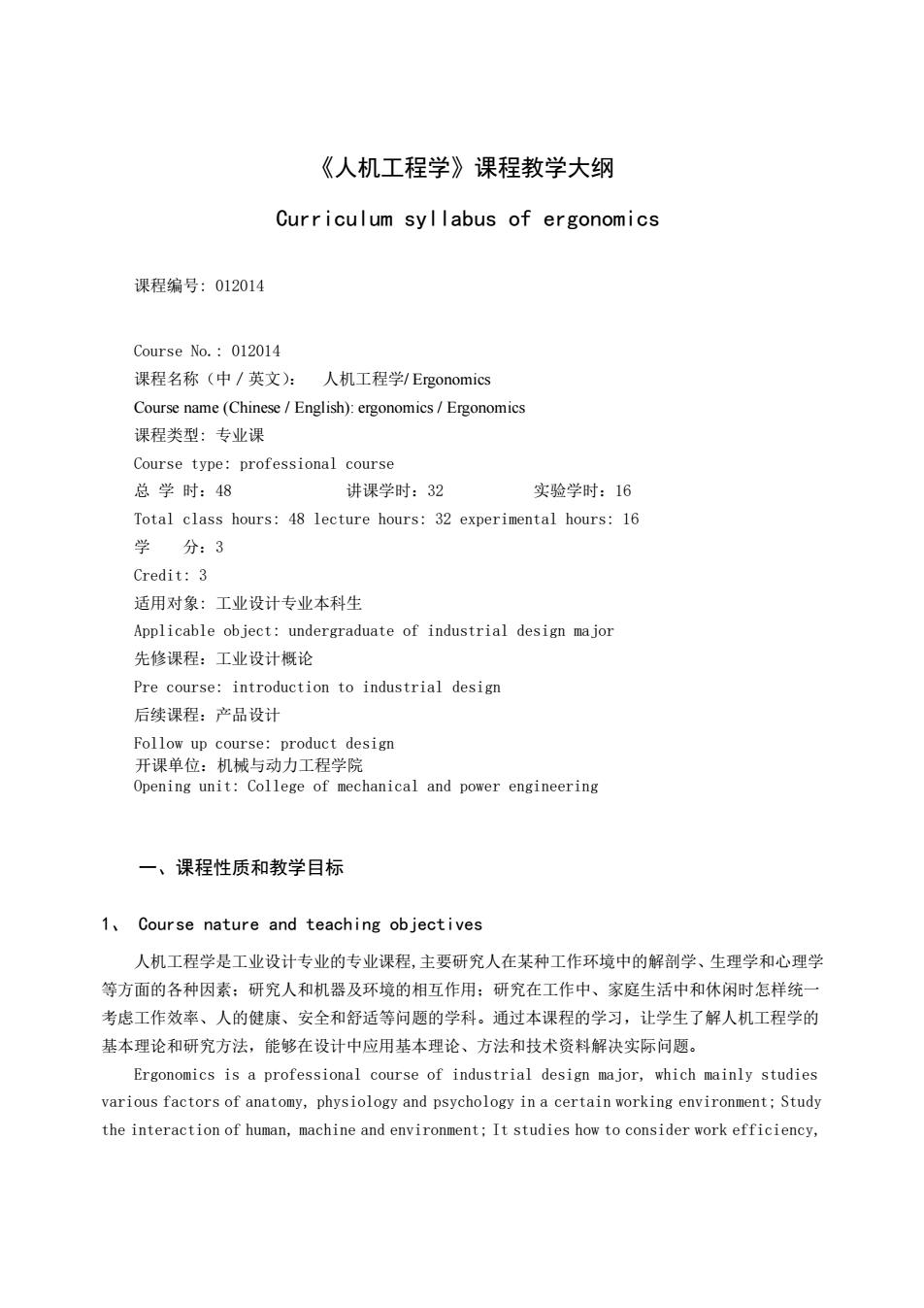
《人机工程学》课程教学大纲 Curriculum syl labus of ergonomics 课程编号:012014 Course No.:012014 课程名称(中/英文):人机工程学/Ergonomics Course name(Chinese/English):ergonomics/Ergonomics 课程类型:专业课 Course type:professional course 总学时:48 讲课学时:32 实验学时:16 Total class hours:48 lecture hours:32 experimental hours:16 学分:3 Credit:3 适用对象:工业设计专业本科生 Applicable object:undergraduate of industrial design major 先修课程:工业设计概论 Pre course:introduction to industrial design 后续课程:产品设计 Follow up course:product design 开课单位:机械与动力工程学院 Opening unit:College of mechanical and power engineering 一、课程性质和教学目标 1.Course nature and teaching objectives 人机工程学是工业设计专业的专业课程,主要研究人在某种工作环境中的解剖学、生理学和心理学 等方面的各种因素:研究人和机器及环境的相互作用:研究在工作中、家庭生活中和休闲时怎样统一 考虑工作效率、人的健康、安全和舒适等问题的学科。通过本课程的学习,让学生了解人机工程学的 基本理论和研究方法,能够在设计中应用基本理论、方法和技术资料解决实际问题。 Ergonomics is a professional course of industrial design major,which mainly studies various factors of anatomy,physiology and psychology in a certain working environment:Study the interaction of human,machine and environment:It studies how to consider work efficiency
《人机工程学》课程教学大纲 Curriculum syllabus of ergonomics 课程编号: 012014 Course No.: 012014 课程名称(中/英文): 人机工程学/ Ergonomics Course name (Chinese / English): ergonomics / Ergonomics 课程类型: 专业课 Course type: professional course 总 学 时:48 讲课学时:32 实验学时:16 Total class hours: 48 lecture hours: 32 experimental hours: 16 学 分:3 Credit: 3 适用对象: 工业设计专业本科生 Applicable object: undergraduate of industrial design major 先修课程:工业设计概论 Pre course: introduction to industrial design 后续课程:产品设计 Follow up course: product design 开课单位:机械与动力工程学院 Opening unit: College of mechanical and power engineering 一、课程性质和教学目标 1、 Course nature and teaching objectives 人机工程学是工业设计专业的专业课程,主要研究人在某种工作环境中的解剖学、生理学和心理学 等方面的各种因素;研究人和机器及环境的相互作用;研究在工作中、家庭生活中和休闲时怎样统一 考虑工作效率、人的健康、安全和舒适等问题的学科。通过本课程的学习,让学生了解人机工程学的 基本理论和研究方法,能够在设计中应用基本理论、方法和技术资料解决实际问题。 Ergonomics is a professional course of industrial design major, which mainly studies various factors of anatomy, physiology and psychology in a certain working environment; Study the interaction of human, machine and environment; It studies how to consider work efficiency
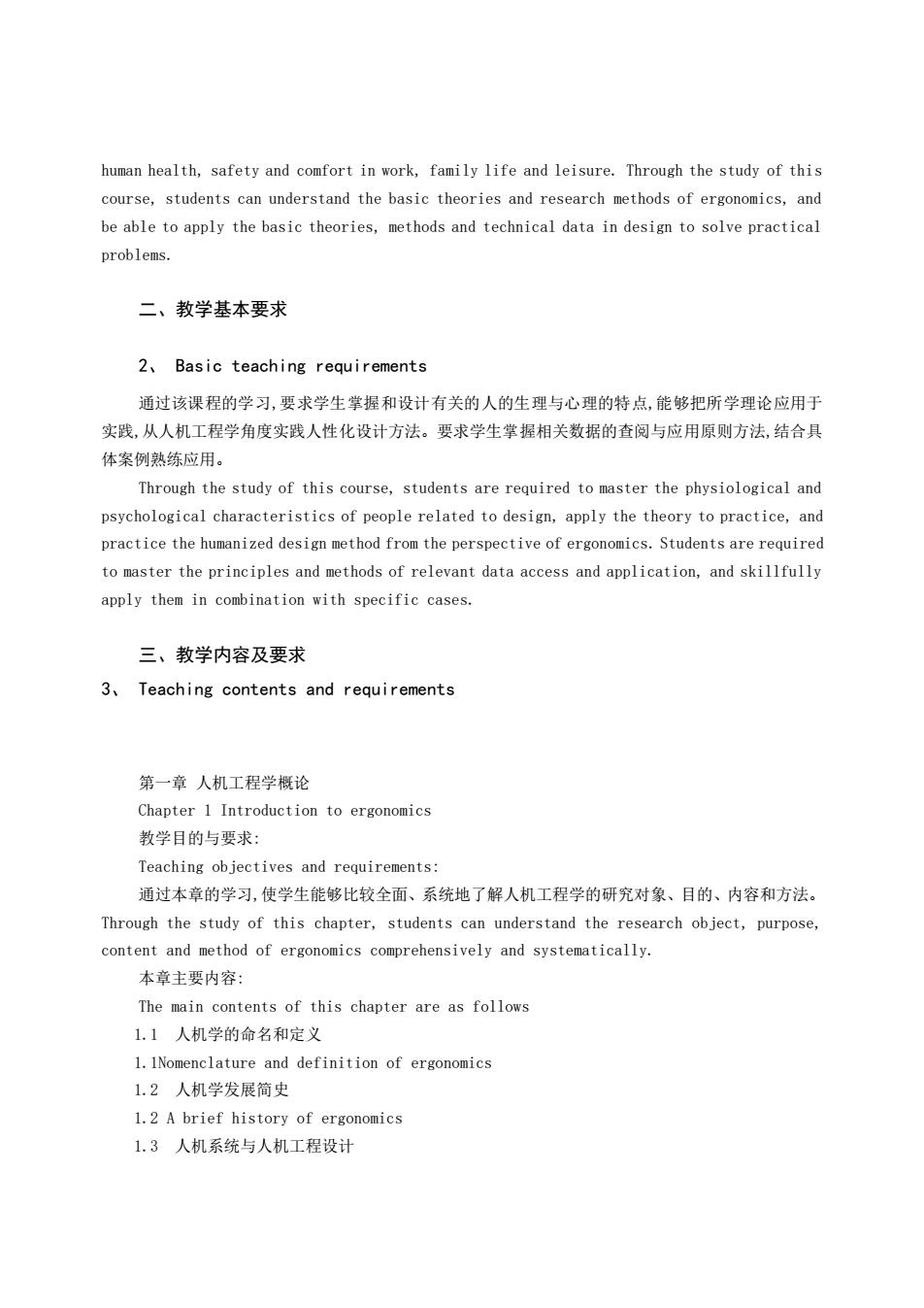
human health.safety and comfort in work.family life and leisure.Through the study of this course,students can understand the basic theories and research methods of ergonomics,and be able to apply the basic theories,methods and technical data in design to solve practical problems. 二、教学基本要求 2.Basic teaching requirements 通过该课程的学习,要求学生掌握和设计有关的人的生理与心理的特点,能够把所学理论应用于 实践,从人机工程学角度实践人性化设计方法。要求学生掌握相关数据的查阅与应用原则方法,结合具 体案例熟练应用。 Through the study of this course,students are required to master the physiological and psychological characteristics of people related to design,apply the theory to practice,and practice the humanized design method from the perspective of ergonomics.Students are required to master the principles and methods of relevant data access and application,and skillfully apply them in combination with specific cases. 三、教学内容及要求 3.Teaching contents and requirements 第一章人机工程学概论 Chapter 1 Introduction to ergonomics 教学目的与要求: Teaching obiectives and reguirements: 通过本章的学习,使学生能够比较全面、系统地了解人机工程学的研究对象、目的、内容和方法。 Through the study of this chapter,students can understand the research object,purpose content and method of ergonomics comprehensively and systematically 本章主要内容: The main contents of this chapter are as follows 1.1人机学的命名和定义 1.INomenclature and definition of ergonomics 1.2人机学发展简史 1.2 A brief history of ergonomics 1.3人机系统与人机工程设计
human health, safety and comfort in work, family life and leisure. Through the study of this course, students can understand the basic theories and research methods of ergonomics, and be able to apply the basic theories, methods and technical data in design to solve practical problems. 二、教学基本要求 2、 Basic teaching requirements 通过该课程的学习,要求学生掌握和设计有关的人的生理与心理的特点,能够把所学理论应用于 实践,从人机工程学角度实践人性化设计方法。要求学生掌握相关数据的查阅与应用原则方法,结合具 体案例熟练应用。 Through the study of this course, students are required to master the physiological and psychological characteristics of people related to design, apply the theory to practice, and practice the humanized design method from the perspective of ergonomics. Students are required to master the principles and methods of relevant data access and application, and skillfully apply them in combination with specific cases. 三、教学内容及要求 3、 Teaching contents and requirements 第一章 人机工程学概论 Chapter 1 Introduction to ergonomics 教学目的与要求: Teaching objectives and requirements: 通过本章的学习,使学生能够比较全面、系统地了解人机工程学的研究对象、目的、内容和方法。 Through the study of this chapter, students can understand the research object, purpose, content and method of ergonomics comprehensively and systematically. 本章主要内容: The main contents of this chapter are as follows 1.1 人机学的命名和定义 1.1Nomenclature and definition of ergonomics 1.2 人机学发展简史 1.2 A brief history of ergonomics 1.3 人机系统与人机工程设计
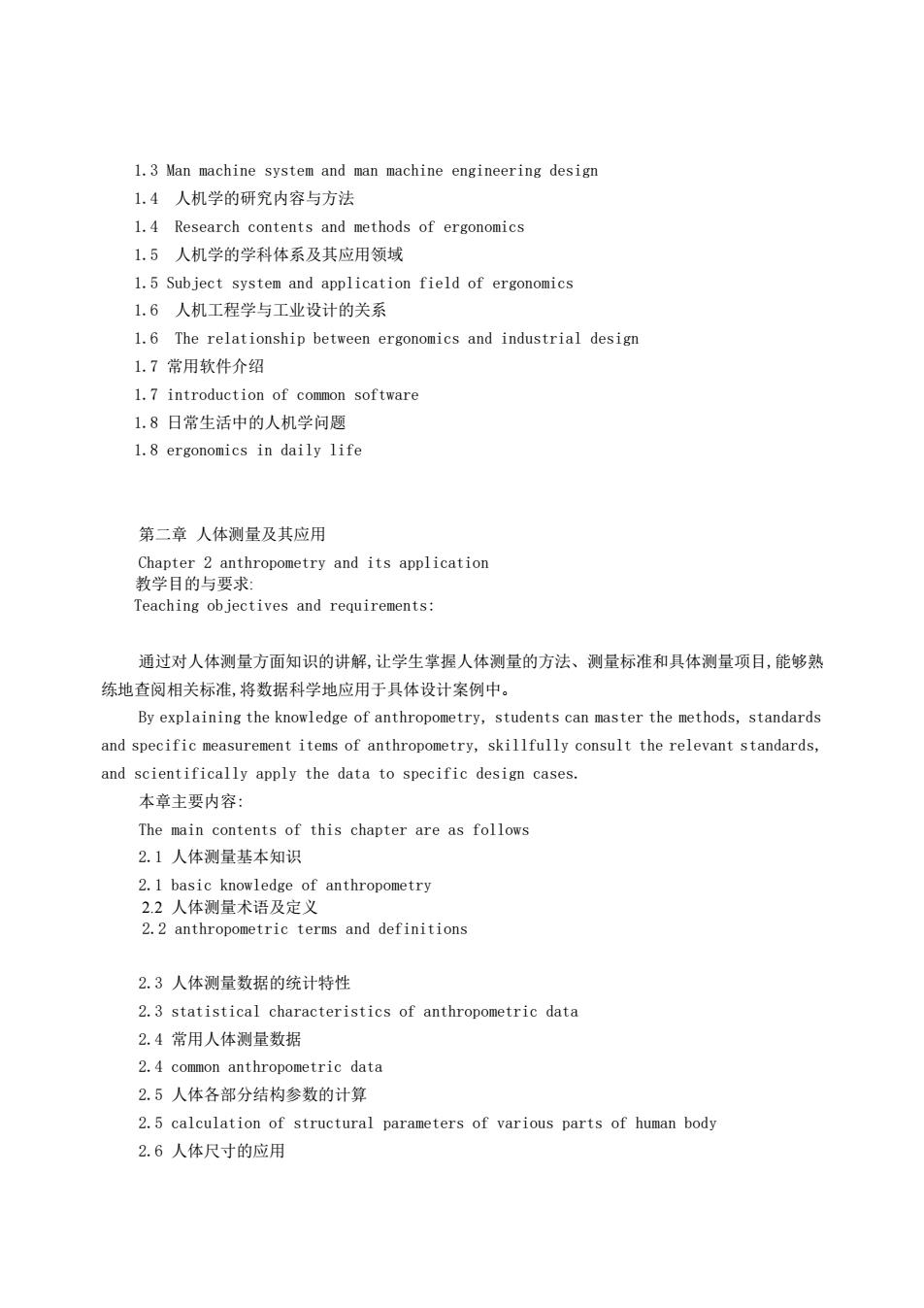
1.3 Man machine system and man machine engineering design 1.4人机学的研究内容与方法 1.4 Research contents and methods of ergonomics 1.5人机学的学科体系及其应用领域 1.5 Subject system and application field of ergonomics 1.6人机工程学与工业设计的关系 1.6 The relationship between ergonomics and industrial design 1.7常用软件介绍 1.7 introduction of common software 1.8日常生活中的人机学问题 1.8 ergonomics in daily life 第二章人体测量及其应用 Teaching objectives and requirements 通过对人体测量方面知识的讲解,让学生掌握人体测量的方法、测量标准和具体测量项目,能够熟 练地查阅相关标准,将数据科学地应用于具体设计案例中。 By explaining the knowledge of anthropometry,students can master the methods,standards and specific measurement items of anthropometry,skillfully consult the relevant standards. and scientifically apply the data to specific design cases. 本章主要内容: The main contents of this chapter are as follows 2.1人体测量基本知识 2.1 basic knowledge of anthropometry 22人体测量术语及定义 2.2 anthropometric terms and definitions 2.3人体测量数据的统计特性 2.3 statistical characteristics of anthropometric data 2.4常用人体测量数据 2.4 common anthropometric data 2.5人体各部分结构参数的计算 2.5 calculation of structural parameters of various parts of human body 2.6人体尺寸的应用
1.3 Man machine system and man machine engineering design 1.4 人机学的研究内容与方法 1.4 Research contents and methods of ergonomics 1.5 人机学的学科体系及其应用领域 1.5 Subject system and application field of ergonomics 1.6 人机工程学与工业设计的关系 1.6 The relationship between ergonomics and industrial design 1.7 常用软件介绍 1.7 introduction of common software 1.8 日常生活中的人机学问题 1.8 ergonomics in daily life 第二章 人体测量及其应用 Chapter 2 anthropometry and its application 教学目的与要求: Teaching objectives and requirements: 通过对人体测量方面知识的讲解,让学生掌握人体测量的方法、测量标准和具体测量项目,能够熟 练地查阅相关标准,将数据科学地应用于具体设计案例中。 By explaining the knowledge of anthropometry, students can master the methods, standards and specific measurement items of anthropometry, skillfully consult the relevant standards, and scientifically apply the data to specific design cases. 本章主要内容: The main contents of this chapter are as follows 2.1 人体测量基本知识 2.1 basic knowledge of anthropometry 2.2 人体测量术语及定义 2.2 anthropometric terms and definitions 2.3 人体测量数据的统计特性 2.3 statistical characteristics of anthropometric data 2.4 常用人体测量数据 2.4 common anthropometric data 2.5 人体各部分结构参数的计算 2.5 calculation of structural parameters of various parts of human body 2.6 人体尺寸的应用
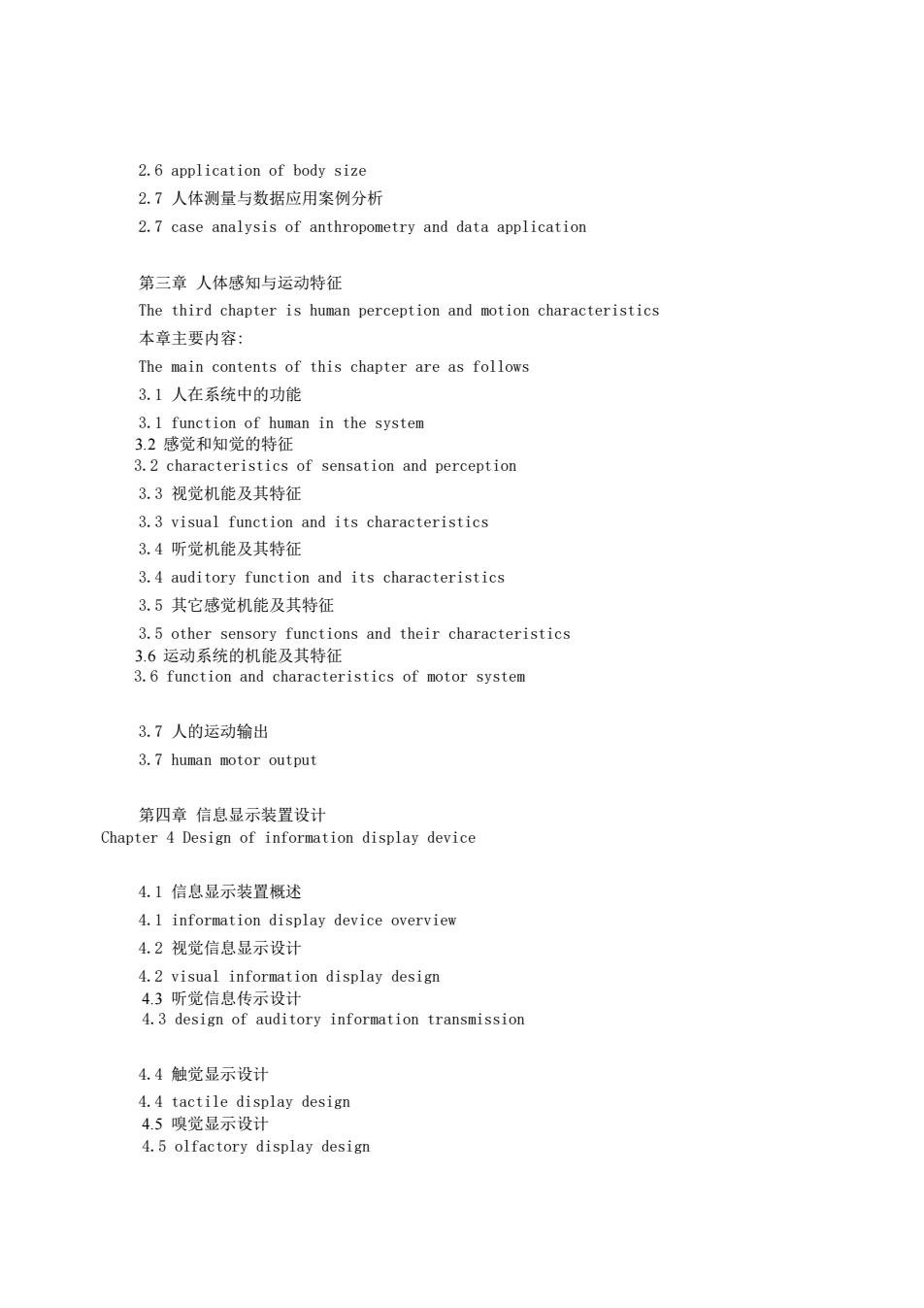
2.6 application of body size 2.7人体测量与数据应用案例分析 2.7 case analysis of anthropometry and data application 第三章人体感知与运动特征 The third chapter is human perception and motion characteristics 本章主要内容: The main contents of this chapter are as follows 3.1人在系统中的功能 3.1 function of human in the system 3.2感觉和知觉的特征 3.2 characteristics of sensation and perception 3.3视觉机能及其特征 3.3 visual function and its characteristics 3.4听觉机能及其特征 3.4 auditory function and its characteristics 3.5其它感觉机能及其特征 3.5 other sensory functions and their characteristics 3.6运动系统的机能及其特征 3.6 function and characteristics of motor system 3.7人的运动输出 3.7 human motor output 第四查信息品示转置设计 Chapter 4 Design of information display device 4.1信息显示装置概述 4.1 information display device overview 4.2视觉信息显示设计 4.2 visual information display design 43听觉信息传示设计 4.3 design of auditory information transmission 4.4触觉显示设计 4.4 tactile display design 4.5嗅觉显示设计 4.5 olfactory display design
2.6 application of body size 2.7 人体测量与数据应用案例分析 2.7 case analysis of anthropometry and data application 第三章 人体感知与运动特征 The third chapter is human perception and motion characteristics 本章主要内容: The main contents of this chapter are as follows 3.1 人在系统中的功能 3.1 function of human in the system 3.2 感觉和知觉的特征 3.2 characteristics of sensation and perception 3.3 视觉机能及其特征 3.3 visual function and its characteristics 3.4 听觉机能及其特征 3.4 auditory function and its characteristics 3.5 其它感觉机能及其特征 3.5 other sensory functions and their characteristics 3.6 运动系统的机能及其特征 3.6 function and characteristics of motor system 3.7 人的运动输出 3.7 human motor output 第四章 信息显示装置设计 Chapter 4 Design of information display device 4.1 信息显示装置概述 4.1 information display device overview 4.2 视觉信息显示设计 4.2 visual information display design 4.3 听觉信息传示设计 4.3 design of auditory information transmission 4.4 触觉显示设计 4.4 tactile display design 4.5 嗅觉显示设计 4.5 olfactory display design
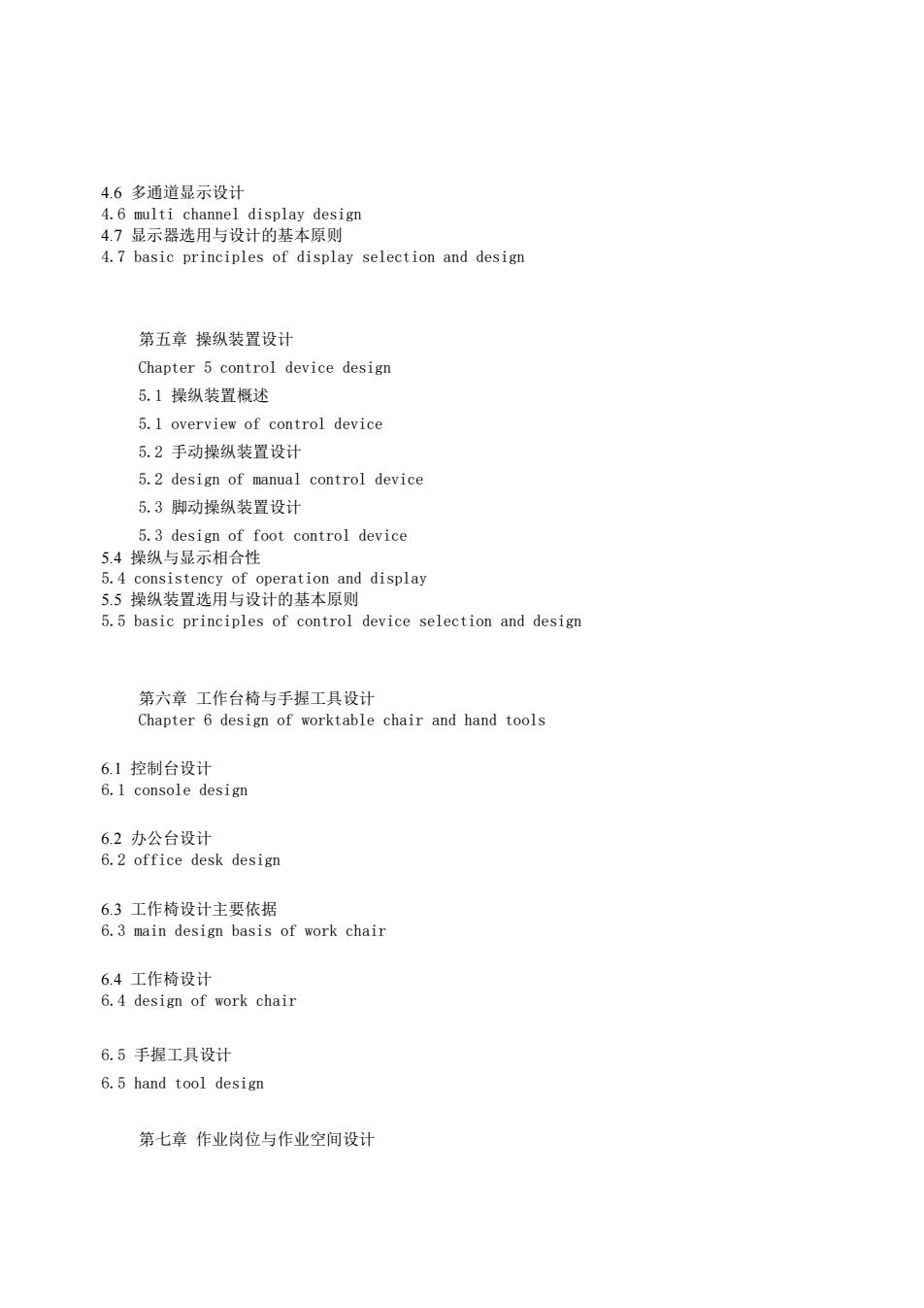
46多诵道品示设计 4.6 multi channel display design 4.7显示器选用与设计的基本原则 4.7 basic principles of display selection and design 第五章操纵装置设计 Chapter 5 control device design 5.1操纵装置概述 5.1 overview of control device 5.2手动操纵装置设计 5.2 design of manual control device 5.3脚动操纵装置设计 5.3 design of foot control device 5.4操纵与显示相合性 5.4 consistency of operation and display 5.5操纵装置选用与设计的基本原则 5.5 basic principles of control device selection and design 第六章工作台椅与手握工具设计 Chapter 6 design of worktable chair and hand tools 6.1控制台设计 6.1 console design 6.3工作椅设计主要依据 6.3 main design basis of work chair 64工作椅设计 6.4 design of work chair 6.5手握工具设计 6.5 hand tool design 第七章作业岗位与作业空间设计
4.6 多通道显示设计 4.6 multi channel display design 4.7 显示器选用与设计的基本原则 4.7 basic principles of display selection and design 第五章 操纵装置设计 Chapter 5 control device design 5.1 操纵装置概述 5.1 overview of control device 5.2 手动操纵装置设计 5.2 design of manual control device 5.3 脚动操纵装置设计 5.3 design of foot control device 5.4 操纵与显示相合性 5.4 consistency of operation and display 5.5 操纵装置选用与设计的基本原则 5.5 basic principles of control device selection and design 第六章 工作台椅与手握工具设计 Chapter 6 design of worktable chair and hand tools 6.1 控制台设计 6.1 console design 6.2 办公台设计 6.2 office desk design 6.3 工作椅设计主要依据 6.3 main design basis of work chair 6.4 工作椅设计 6.4 design of work chair 6.5 手握工具设计 6.5 hand tool design 第七章 作业岗位与作业空间设计